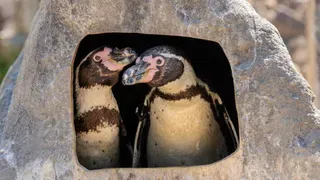August 22, 2015
Trans Murder Rates Are Out of Control
Kilian Melloy READ TIME: 5 MIN.
"How many of you have been verbally harassed because you are transgender?" asks Ruby Corado, executive director of Casa Ruby, as she sits in a circle with 12 other transgender women one recent Saturday afternoon.
All thirteen hands, including Corado's, fly up.
"How many have ever been physically harassed, or hit, or attacked because you were transgender?" Corado asks.
Nine raise their hands.
For many of these women, knowing that they can be targeted for violence is an accepted part of life. Even though D.C. hasn't had a transgender murder since the killing of Deoni Jones in February 2012, the women at Casa Ruby are aware of - and some have even been the victims of - other crimes. And a simple look at social media and news websites will reveal attacks or murders against transgender women in other major cities.
The threat has become particularly apparent in the past few weeks, with seven women killed in the last month alone. In total, 16 transgender women were murdered so far in 2015, a number surpassing last year's. What's more, 14 of the 16 victims were transgender women of color.
"My personal reaction is horror," says Mara Keisling, executive director of the National Center for Transgender Equality. "We've known since some time last fall that, for some reason, the murders were increasing. I think it has been on every trans person's mind."
Stacey Long Simmons, director of public policy and government affairs for the National LGBTQ Task Force, says the number of transgender murders has been in the double digits for the past two to three years.
"There is, in some cases, a backlash that happens by those who don't really support our community, or us having legal protections," Simmons says. "I don't think that's the only reason, though. All of the contributing factors that we've been paying attention to have to do with the economics of the situation and how there's still a level of societal intolerance and a lack of accountability in terms of how trans women's bodies are treated, and the lack of respect that trans women, particularly trans women of color, receive when they're in public spaces."
Both Keisling and Simmons stress that tackling the issue of anti-transgender violence requires addressing other factors that place transgender women at greater risk of victimization.
"There's no 'magic bullet' solution," says Keisling. "It's a complex problem. It's not as simple as: 'Stop the Violence.' It's about transphobia and racism and poverty, and the criminal justice system, and the marginalization of transgender people in terms of school and jobs. It's about rejection by family. Because of the small number of trans people there are in the country, it may not look to folks, at first blush, like an epidemic. But when you look at the number of trans people there are - and the number of trans women and trans women of color - you realize that this is a catastrophic, horrible public health crisis that the government ought to care about."
LGBT advocates and trans activists have created a petition calling for the Obama administration to formally investigate the causes of the rising death toll among transgender women of color. The petition has so far received 1,794 signatures. To merit a response from the White House, it must garner 98,206 signatures by Sept. 9.
Simmons says the Task Force is separately calling on the Obama administration to publicly respond to the rash of killings, just as he did in response the massacre of nine African-Americans in a Charleston, S.C., church.
"That's the symbolic piece that I think goes a long way, that's a signal from the top," says Simmons. "If you can imagine being a young trans women of color, to hear the president say, 'I care about you. I care about your life, and I'm going do all that's within in my power to make sure you live beyond the age of 30,' would mean a lot. So many of these women are so young when they're cut down by violence. It's something that takes a toll on our community, and it's something we need to be talking about every day of the year, not just on the November Trans Day of Remembrance."
Back at Casa Ruby, Bela Muney, of Southeast Washington, says that growing societal acceptance of transgenderism has led to changes in the way trans women are treated in the District.
"Back in the day, when we walked down the street, there'd be rocks thrown, bottles thrown," Muney says. "It's more accepting now than it was, even three years ago."
Muney has been the victim of three separate incidents where she feels she was targeted for her gender identity. In May, she was robbed and had a gun held to her head. Just last month, she was hit with several paintballs by some male youths.
"The police officer was sitting on the corner," Muney recalls. "And I said, 'You didn't see this?' He said he was off duty."
Still, other police officers - particularly those from the Gay and Lesbian Liaison Unit (GLLU) - were helpful after the May incident.
"They caught the guy who had the gun to my head in one day," Muney says. "If it wasn't for Miss Jessica Hawkins, the trans woman on the police force, I don't think they would have caught him."
Muney is keenly aware that cases involving transgender victims may not be prioritized or may remain unsolved for years.
"I have police officer friends, and they tell me all the time, 'Trans girls always go to the back. It's the back burner. It's not the main focus,'" she says. "A lot of stuff they tell me, they shouldn't. But it's just for my safety and me to be aware of what's going on around me."
Muney believes that the reason transgender women are so often targets for violence stems from insecurity. "I mean, look at us," she says. "Women are intimidated by us because of the way we look, the way we dress. They see us as competition, but we're not competition to you. We're not even trying to be like you... . And guys are intimidated because they're insecure with their sexuality. They don't know what they really are. They're intrigued by us - a lot of men tell me I'm very exotic."
Nona, another Southeast D.C. resident, is also a survivor of violence. She was hospitalized for six days in June 2013 after an acquaintance stabbed her over 40 times when he discovered that she was transgender. Nona says the man tried to rape her, and kept stabbing her, as she points to a multitude of scars along the right side of her body from her shoulder down to her calves, on her neck, her arms and her wrists.
"The person who attacked me, I think it was a mental thing," she says. "He didn't want to believe it, even though everyone in the neighborhood told him I was transgender."
Nona says another reason why transgender women often find themselves the target of violence may be due to the attackers' unresolved issues with their own sexuality. "To a lot of guys, we're forbidden fruit, and they just can't handle it," she says. "But with hate crimes, it depends on a person's mental state. Because at the end of the day, you find a lot of stuff distasteful, but you don't attack it."
Nona empathizes with the family members and friends of transgender victims who have lost their lives in other cities, saying it's saddening to think about the loss of life and the lack of dignity afforded trans women.
"My heart goes out to them, especially because I'm a survivor," Nona says. "I think, 'That could be me.'"
Kilian Melloy serves as EDGE Media Network's Associate Arts Editor and Staff Contributor. His professional memberships include the National Lesbian & Gay Journalists Association, the Boston Online Film Critics Association, The Gay and Lesbian Entertainment Critics Association, and the Boston Theater Critics Association's Elliot Norton Awards Committee.

 Copyright MetroWeekly. For more articles from MetroWeekly visit
Copyright MetroWeekly. For more articles from MetroWeekly visit 




